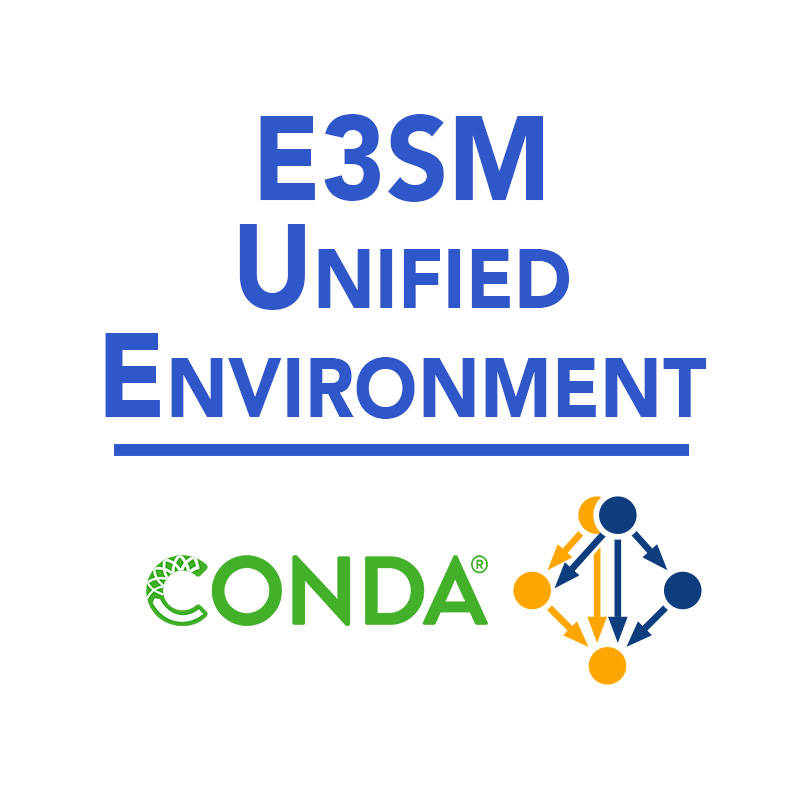E3SM-Unified 1.10.0
We are excited to announce that a new version of E3SM-Unified, 1.10.0, was released in May.
The E3SM project maintains a unified Conda environment, called E3SM-Unified, to ensure that all E3SM-supported software tools are available, coexist together and work seamlessly. All packages upon which the tools depend are included and coordinated to ensure that all tool dependencies are satisfied. Simply by installing this environment, any of the E3SM-supported tools are readily accessible to use.
This new version of E3SM-Unified is a combination of conda and spack environments that includes a collection of a large number of analysis software packages that have been useful for E3SM users. The new version includes updates to several packages developed by the E3SM team including E3SM-Diags, e3sm_to_cmip, MPAS-Analysis, MOAB, NCO, xcdat, zppy, and zstash (as detailed below).
E3SM-Unified is available on 9 machines supported by E3SM: Acme1 (LLNL), Andes (ORNL), Anvil (ANL), Chicoma (LANL), Chrysalis (ANL), Compy (PNNL), Frontier (ORNL), Perlmutter (NERSC), and ALCF Polaris (ANL). It can also be installed on a personal machine as a conda package.
E3SM Unified 1.8.0 was the last version to be highlighted in Floating Points. Since then, there have been a number of improvements.
New and improved in 1.9.0 & 1.10.0
- This new package provides diagnostics for the interactive gas-phase chemistry, newly available in E3SM, to support routine testing and evaluation of the chemistry performance.
- Mixed phase partition diagnostics (mp_partition), also known as T5050 diagnostics
- Wheeler and Kiladis diagram for tropical subseasonal diags contributed from SciDAC QBO team
- The ARM diagnostics (arm_diags) set is enhanced with new aerosol-cloud-interaction and aerosol activation metrics developed by the ARM infrastructure team
- The aerosol budget diagnostics (aerosol_budget) is updated by including global mean burdens, source/sink budgets and lifetimes for aerosol species contributed by Aerosol Working Group.
- GPCP v3.2 precipitation data is added to replace an older version (v2.2). Surface relative humidity and wind speed data set derived from ERA5 are added as standard evaluation sets.
- Major revamp in the implementation of land and atm variable handlers. They are now defined in a single yaml file rather than as individual Python modules.
- A set of tools used to integrate new meshes into E3SM
cube_to_target,gen_domain,interpinic,mksurfdata_map,squadgen
- New waves analysis and moves added to Adusumilli et al. (2020) for Antarctic melt-rate observations
MOAB:
- Significant improvements in both robustness and performance for parallel, conservative map generation, and extensions to support bilinear map projections through TempestRemap v2.2.0.
NCO:
- Simplified invocation of quantization and codecs. CF-compliant longitude boundaries. Fixes for Intel compilers. NCZarr features. Vertical interpolation improvements. EAMxx support
- A newly developed graphical tool that supports visualizing NetCDF data on unstructured grid.
R:
- A free software environment for statistical computing and graphics.
- Provides Xarray-styled functionality for working with unstructured grids build around the UGRID conventions.
- Support an optional user-specified climatology reference period when calculating climatologies and departures
- Improved support for using custom time coordinates in temporal APIs.
zppy:
- Plugin functionality – users can now create plugins to add custom tasks to
zppy. - New
reservationparameter added to allow use of a specific reservation on the job scheduler. - Choose to generate all variables in
climoortsby settingvars="" - Directly choose the value for the
ncclimo--paralleloption - Wave number frequency plot added in
e3sm_diags. global_time_seriesupdated to support hemispheric averaging and plotting of any user-specified variable.
- The
--includeoption allows users to specify which files to include - The
--follow-symlinksoption allows users to copy symlinks, which is helpful in preventing broken links.
Next version
Testing of the next version (E3SM-Unified 1.11.0) is set to begin in Fall of 2024.
Resources
- main page: E3SM Unified Environment
- E3SM-Unified 1.9.0
- E3SM-Unified 1.8.0
- Latest Suite of Analysis Tools: E3SM-Unified 1.5.0
- E3SM-Unified Environment Update
- E3SM Unified Environment v1.3.0
Contact
- Xylar Asay-Davis, Los Alamos National Laboratory
This article is a part of the E3SM “Floating Points” Newsletter, to read the full Newsletter check:



